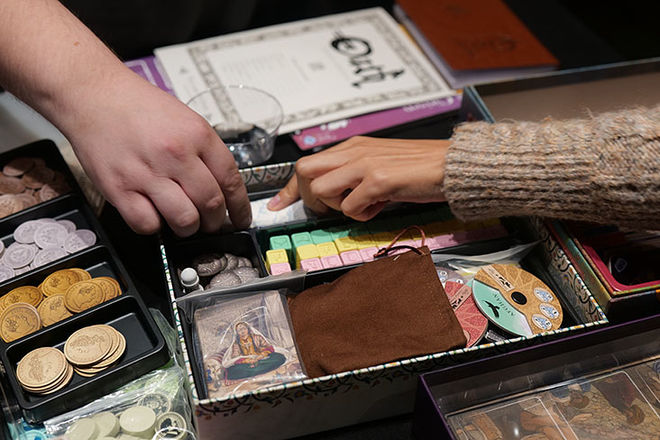
Photo by Hemamset Angaza.
As a child, Jesse Merandy loved playing sports-themed games, including video games produced by EA Sports. He remembers being intrigued by their slogan, “It’s in the game,” and the invitation it presented. This interest in sports games persisted into adulthood. “What I love about these games,” Merandy said, “is that they allow us, in some small way, to insert ourselves into that world.”
Merandy’s formative experiences with games and his role as director of BGC’s Digital Humanities/Digital Exhibitions program sparked his curiosity. He knew that cultural institutions and museums use objects to create pathways to history and human stories and felt that the same could be done with games. He began considering how gaming principles could be used to engage BGC visitors in the gallery and searching for sports games on eBay, where he discovered early cardboard precedents for modern games. He was struck by their whimsical simplicity: “They provide some basic materials, instructions and rules, and the rest is up to us. I wondered, where does the power and potency of gaming come from? What is it about a game’s materiality that draws us in?”
These questions laid the foundation for Merandy’s fall 2023 course, Get in the Game. With the assistance of his colleagues, BGC’s educational technologist Julie Fuller and associate curator of exhibitions Emma Cormack (MA ’18), he created a syllabus that explored the material world of gaming from the nineteenth century to the present, from board games to virtual reality, and investigated how other museums and cultural institutions have used tools such as scavenger hunts or apps to create gaming experiences that engage their visitors.
While conducting research to prepare for teaching the course, Merandy stumbled upon New-York Historical Society (NYHS)’s Liman Collection of antique games. He said, “These games were some of the first printed in the United States and are an important record of early game design, manufacturing, and marketing in nineteenth-century America. I realized it would be an incredible experience for students to encounter them in person; to appreciate their materiality and details up close; and then use that experience as a baseline for other games they would research throughout the semester.” Fortuitously, Merandy discovered that Bard Graduate Center alumna Rebecca Klassen (MA ’11), curator of material culture at NYHS, oversees the Liman Collection and has organized small-scale exhibitions that explore different themes and genres of games.
Merandy corresponded with Klassen and noted, “From our first conversation, Rebecca was incredibly accommodating and generous with her time.” After she presented him with a long list of games in the collection, he chose ten that would complement course readings about game design and reflect the cultural contexts that affected aesthetic and conceptual trends in board games, including the emergence of the parlor in the mid-nineteenth century, the events of the Civil War, and an increasing interest in travel.
Merandy and Klassen planned a class visit to NYHS’s storage facility in Jersey City where the Liman Collection is housed. Klassen carefully unboxed examples of strategy and dexterity-based games, educational games, games about sports, and racing games where the goal is to get to the finish line first. She drew attention to design elements including historical context, materiality, mechanical and artistic elements, and advertisements.
Merandy emphasized, “These old games had a lot of the same elements that make modern games popular, like physical interaction with miniatures and pieces. Some of them were visually intricate and featured early examples of chromolithographic printing. There is an amazing juxtaposition of simple materials, like cardboard, and the complex worlds they were used to create.”
Students enjoyed seeing Game of District Messenger Boy (1886), in which players moved tin messenger boy figurines around the board with the goal of becoming the president of the telegraph company; The Great Game of Pharaoh’s Frogs (1891), in which molded tin and wire frogs leapt into a painted cardboard pond; and Chiromagica or the Hand of Fate (1870), which instructed players to ask questions and then place a paper disc beneath a hand-shaped dial that magically (with the help of magnets) pointed to the answer; and The Game of Basket Ball (1898), whose illustrations of Victorian girls playing basketball reflect the creation of sports teams at women’s colleges.
Merandy was naturally drawn to Game of Base Ball (1886), which featured metal baseball player figurines on a board printed to look like a baseball diamond, and Fuller was fascinated by Les Anamorphoses (1873), a set of distorted lithographic images that came into focus when viewed through an accompanying metal tube.
MA student Ev Christie reflected, “Seeing Rebecca interact with these games gave us a better sense of how people might have enjoyed playing them over a hundred years ago,” and Christie’s classmate Abby Meyers felt that the field trip allowed her to “engage with the multi-sensory aspects of gameplay.” Visiting the storage facility was itself a valuable experience that allowed students to see how museums store and preserve these kinds of objects. Fuller noted, “Given that they were constructed primarily from fragile materials like paper and cardboard, it’s surprising what good condition the games were in.”
The interaction with Klassen, a BGC alumna who now works as a curator in an important and highly regarded New York City museum, inspired the students and was “a great reminder of the flourishing community of professionals in the cultural heritage sector that got their start at Bard Graduate Center,” according to Merandy. In the future, he hopes to help create a “gamified game exhibition” that features some of these historical board games and encourages visitors to engage with them using gaming principles.











